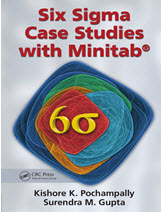 Book reviews
Book reviews-
Six Sigma Case Studies with Minitab?
Publisher
:
CRC Press, Boca Raton
Title
:
Six Sigma Case Studies with Minitab?
Authors Kishore K. Pochampally and Surendra M. Gupta Year of Publication
:
2014
Pages
:
302
ISBN
:
978-1-4822-0557-2
Reviewer
:
Krishna B. Misra
Status
:
Review Complete
The books comprises 15 chapters arranged under two sections and are preceded by a Preface, Acknowledgements and About the Authors and followed by an Appendix and Index.
Section I Background
Chapter 1
Introduction to Six Sigma Quality
11 Pages
Chapter 2
Quality Analysis and Improvement Tools/Techniques used in this Book
06 Pages
Section II Six Sigma Case Studies
Chapter 3
Confidence Intervals to Assess Variation in Fat Content at a Fast-Food Restaurant
20 Pages
Chapter 4
Hypothesis Testing for Quality Control at a Manufacturing Company
18 Pages
Chapter 5
Chi-Square Analysis to Verify Quality of Candy Packets
19 Pages
Chapter 6
Process Capability Analysis at a Manufacturing Company
23 Pages
Chapter 7
Binary Logistic Regression to Predict Customer Satisfaction
14 Pages
Chapter 8
Item Analysis and Cluster Analysis to Gather “Voice of the Customer” (VOC) Data from Employees at a Service Firm
17 Pages
Chapter 9
Mixture Designs to Optimize Pollution Level and Temperature of Fuels
24 Pages
Chapter 10
Multivariate Analysis to Reduce Patient Waiting Time at a Medical Centre
23 Pages
Chapter 11
Pareto Chart and Fishbone Diagram to Minimize Recyclable Disposal in a Town
10 Pages
Chapter 12
Measurement System Analysis at a Medical Equipment Manufacturer
19 Pages
Chapter 13
Taguchi Design to Improve Customer Satisfaction of an Airline Company
14 Pages
Chapter 14
Factorial Design of Experiments to Optimize a Chemical Process
25 Pages
Chapter 15
Chi-Square Tests to Verify Source Association with Parts Purchased and Products Produced
16 Pages
Appendix
19 Pages
Index
10 Pages
This book is authored by experienced professors who have been teaching in the area and have also done
 several projects extensively. Six Sigma has been the most popular and widely used technique with the manufacturers for ensuring process quality, these days. Therefore, the importance of a book for understanding Six Sigma in all its potential is highly welcome.
several projects extensively. Six Sigma has been the most popular and widely used technique with the manufacturers for ensuring process quality, these days. Therefore, the importance of a book for understanding Six Sigma in all its potential is highly welcome.The authors have done extremely well to present it in a simple to understand language and bring out the potential of Six Sigma by presenting numerous case studies from improving the quality of candy packets to service improvement of an Airline, in addition to covering several other sectors.
As is well-known that Six Sigma uses five steps methodology, called as DMAIC, namely, Define, Measure, Analyze, Improve, and Control. The authors clearly demonstrate these steps with each and every case study presented the book in chapters 3-15. Also as Minitab is the leading and user-friendly statistical software used in quality improvement and works well with integer as well as with fractional data; using Minitab has improved the utility of the book immensely. The book is recommended to all graduate students interested in quality engineering and to managers in various companies desirous of improving quality of their products or services.
This review has been published in Vol. 11, No. 6, November 2015 issue of the IJPE

